Strip Steak
J. Kenji López-Alt is the Managing Culinary Director of Serious Eats, author of the James Beard Award-nominated column The Food Lab, and a columnist for Cooking Light. He lives in San Francisco. A New York native, Kenji cut his cooking chops the old-fashioned way by wo ...
Highly marbled cuts like a grain-finished Prime-grade ribeye and strip should be cooked a few degrees Fahrenheit higher than leaner steaks like tenderloin, since their copious intramuscular fat helps keep them moist while delivering plenty of flavor. I prefer ribeyes and strip steaks cooked medium-rare to medium, around 129°F / 54°C to 135°F / 57°C. Fattier steaks also have natural insulation which means they'll take slightly longer to reach the correct internal temperature.
Timings are all given for steaks one-and-a-half to two inches thick. For steaks one inch or less, initial cooking time can be shortened to 40 minutes. Steaks cooked under 130°F / 54.4°C should not be cooked longer than two-and-a-half hours at a time for food safety reasons.
Very Rare to Rare: 120°F / 49°C to 128°F / 53°C;1 to 2 1/2 hours
Medium-rare: 129°F / 54°C to 134°F / 57°C;1 to 4 hours*
Medium: 135°F / 57°C to 144°F / 62°C;1 to 4 hours
Medium-well: 145°F / 63°C to 155°F / 68°C; 1 to 3 1/2 hours
Well done: 156°F / 69°C and up; 1 to 3 hours
*2 1/2 hours max if under 130°F / 54°C
Shop Sous Vide Cookers
Precision® Cookers
Perfect results in a few simple steps.
Ingredients for 2
1 1/2-to 2-pounds / 680 to 900 grams bone-in or 1 to 1 1/2-pounds / 450 to 680 grams boneless steaks (1 large strip steak)
Kosher salt and freshly ground black pepper to taste
2 fresh thyme sprigs (optional)
2 fresh rosemary sprigs (optional)
-- Finishing Steps Ingredients --
1 tablespoon / 15 ml vegetable, canola, or rice bran oil
1 tablespoon / 15 ml unsalted butter
3 to 4 fresh thyme sprigs (optional)
3 to 4 fresh rosemary sprigs (optional)
1 small shallot, sliced (optional)
2 whole cloves garlic, smashed (optional)
Coarse sea salt (such as Maldon) to finish
Directions
-
Step 1
Pre-heat your Precision Cooker to the desired final temperature according the the finishing texture, included here and the Anova app. Allow the water bath to come to temperature before adding your steak.
-
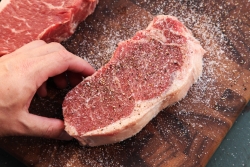
Step 2
If you're planning on cooking and eating them immediately, season generously with salt and pepper, then slide it into a vacuum sealer or heavy-duty plastic bag. If sealing now to freeze or cook for later, omit the salt and pepper (it will get added later on).
-
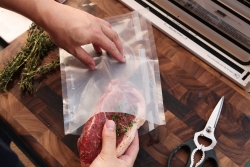
Step 3
If using aromatics like thyme or rosemary sprigs, add a few to the bag now, distributing them evenly on both sides of the steak.
-
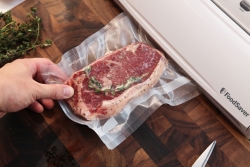
Step 4
Seal the bag either using a vacuum sealer or if using a zipper-lock bag, by using the water displacement method.
-
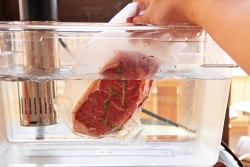
Step 5
Drop the bag in the water bath, making sure not to block the intake our output sections of your Precision Cooker. If properly sealed, the steak should sink.
-
Finishing Steps - Stovetop
-
Step 0
Remove the steak from the bag and place it on a paper towel-lined plate. Pat it dry very carefully on both sides. If you did not season before bagging the steak, season it now generously with salt and pepper.
-
Step 1
Turn on your vents and open your windows. Place a heavy cast-iron or stainless steel skillet with 1 tablespoon / 15 ml of vegetable, canola, or rice bran oil over the hottest burner you have and preheat the skillet until it starts to smoke.
-
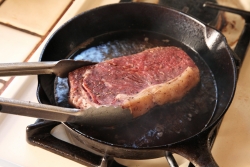
Step 2
Gently lay the steak in the skillet using your fingers or a set of tongs. If desired, add a tablespoon of butter. Butter contains milk solids that will blacken and char, helping your steak achieve a dark crust much faster and adding a characteristic slightly bitter, charred flavor. I happen to like this flavor (and it's typical of a steakhouse experience). For a cleaner-tasting sear, omit the butter at this stage.
-
Step 3
If desired, add aromatics like whole thyme and rosemary sprigs with the leaves still attached, sliced shallots, or crushed whole garlic cloves.
-
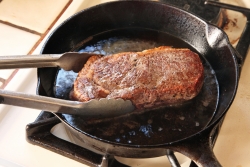
Step 4
After 15 to 30 seconds, flip the steak so that the second side comes into contact with the pan. Repeat, flipping the steak every 15 to 30 seconds until it has developed a nice brown sear, about a minute and a half total. If you did not add butter already, add butter to the skillet now for about 30 seconds before the steak is done for added richness.
-
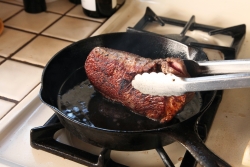
Step 5
Using tongs, pick up the steak and rotate it so that the edge is in direct contact with the skillet. Continue to cook, rotating the steak along this edge until all of the edges are browned, about another 45 seconds total.
-
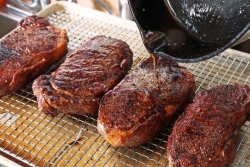
Step 6
Transfer the steak to a wire rack set in a rimmed baking sheet. When ready to serve, reheat any fat and juices left in the pan until sizzling then pour them over the steak to re-crisp and moisten the surface (the steaks can be served immediately if you are ready, no need to rest a sous vide steak). Serve steaks immediately with coarse sea salt such as Maldon on the side.
-
Finishing Steps - Stovetop with a Torch
-
Step 0
Remove the steak from the bag and place it on a paper towel-lined plate. Pat it dry very carefully on both sides. If you did not season before bagging the steak, season it now generously with salt and pepper.
-
Step 1
Turn on your vents and open your windows. Place a heavy cast-iron or stainless steel skillet with 1 tablespoon / 15 ml of vegetable, canola, or rice bran oil over the hottest burner you have and preheat the skillet until it starts to smoke.
-
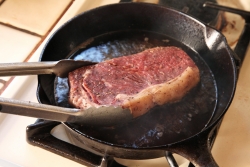
Step 2
Gently lay the steak in the skillet using your fingers or a set of tongs. If desired, add a tablespoon of butter. Butter contains milk solids that will blacken and char, helping your steak achieve a dark crust much faster and adding a characteristic slightly bitter, charred flavor. I happen to like this flavor (and it's typical of a steakhouse experience). For a cleaner-tasting sear, omit the butter at this stage.
-
Step 3
If desired, add aromatics like whole thyme and rosemary sprigs with the leaves still attached, sliced shallots, or crushed whole garlic cloves.
-
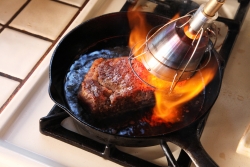
Step 4
Flip the steak immediately and start torching the first side working in slow, even strokes back and forth across its entire surface until it is pale brown with a few darker singed spots. This should take about 30 seconds.
-
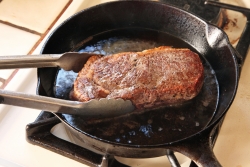
Step 5
If you did not add butter already, add butter to the skillet now for added richness. Flip the steak and torch the second side until it is very well browned, about 30 seconds longer. Flip the steak once more to ensure that the first side has achieved full browning.
-
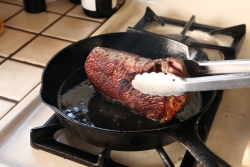
Step 6
Using tongs, pick up the steak and rotate it so that the edge is in direct contact with the skillet. Continue to cook, rotating the steak along this edge until all of the edges are browned, about another 45 seconds total.
-
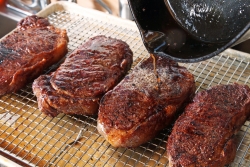
Step 7
Transfer the steak to a wire rack set in a rimmed baking sheet. When ready to serve, reheat any fat and juices left in the pan until sizzling then pour them over the steak to re-crisp and moisten the surface (the steaks can be served immediately if you are ready, no need to rest a sous vide steak). Serve steaks immediately with coarse sea salt such as Maldon on the side.
-
Finishing Steps - Grill
-
Step 0
Make sure to have your grill preheated before your steak comes out of its sous vide bath and bag. Light one chimney full of charcoal. When all the charcoal is lit and covered with gray ash, pour out and arrange the coals on one side of the charcoal grate. Set cooking grate in place, cover grill and allow to preheat for 5 minutes. Alternatively, set half the burners on a gas grill to the highest heat setting, cover, and preheat for 10 minutes. Scrape the grill grates clean with a grill scraper, then oil the grates by holding an oil-dipped kitchen towel or paper towels in a set of tongs and rubbing them over the grates 5 to 6 times.
-
Step 1
Remove the steak from the bag and place it on a paper towel-lined plate. Pat it dry very carefully on both sides. Rub gently with canola, vegetable, or rice bran oil. If you did not season before bagging the steak, season it now generously with salt and pepper.
-
Step 2
Place steak directly over the hot side of the grill and cook, turning every 15 to 30 seconds, until a deep, rich crust has formed, about 1 1/2 minutes total. If the fire threatens to flare up as the steak drips fat into it, suffocate the fire by closing the grill lid until the flames die out. Alternatively, transfer the steak to the cooler side of the grill using a set of long tongs until the flames subside. Do not allow the steak to get engulfed in flames.
-
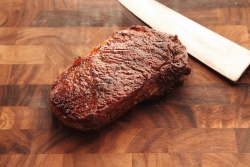
Step 3
Transfer the cooked steak to a cutting board or serving platter and serve immediately.